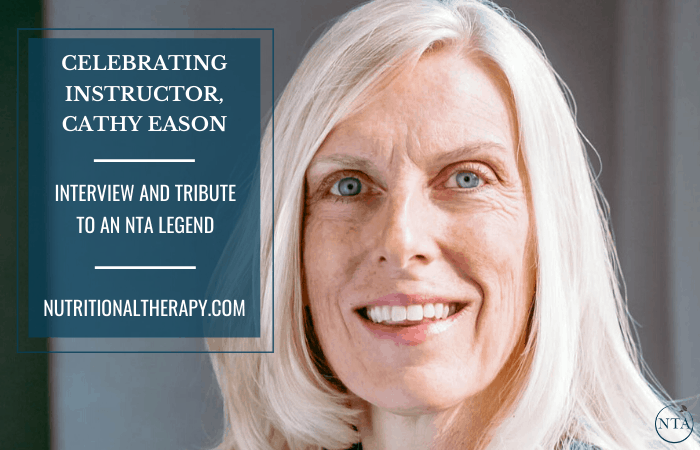
Celebrating NTA Instructor, Cathy Eason: Watch the interview
On May 15, we had the extreme privilege of interviewing Cathy Eason, LMT, FNTP, AIP, GAPS, CFSP, BCHN®. She’s been a great asset to the NTA over the years and we couldn’t let her retire from the NTA without giving us the honor of an interview to showcase all the work she has done and how her legacy will live on through her students and colleagues.Cathy Eason has been a Lead instructor for the NTA for 15 years and is currently teaching her 40th and final practitioner training for the NTA. A 2004 graduate of the first ever Portland class taught by NTA founder, Gray Graham and his remarkable assistant, Colleen Dunseth, Cathy has held many roles within the NTA including Board Member, Shareholder, Curriculum Developer, Director of Education, Lead Instructor, and Program Advocate. Drawn to the NTA by a plain white 4×6 postcard received in the mail a week before class began, Cathy went to a live info session and realized she’d found her people. She signed up the next day and the rest as they say, is history.
+ Watch the interview
INTERVIEW
Tell me about your proudest moments as an NTA instructor? What were 2-3 stories that you remember that made you most proud of making a career choice to be an instructor?
Helping build the NTA along with the handful of other early instructors. We were a very small but dedicated team of a director, an admin manager, and 5 instructors who had to teach ourselves to be teachers. We live lectured everything in classrooms, had to learn to be experts in anatomy and physiology, nutrition, healing tools, and touch. Three of us traveled across the country building venues and spreading word of the training. I’m so grateful I discovered this gift of teaching, and that I had the opportunity to grow myself in the process
Witnessing the personal and professional growth of so many students over the years, seeing the literal lightbulbs turn on and the look in people’s eyes when they finally “get it” and I know I’ve reached them with an important message. That’s when I know I’ve been a good teacher. I think I’m most proud of promoting the development of many of the current instructors who I know to be talented educators and practitioners and who once sat in my classroom as a student. To have them as peers and colleagues is an incredible honor.
Watching two students meet in class the first workshop weekend, the one token man in a class with 39 women. Before the second weekend I’d figured out they were dating when I busted them together on a conference call but knew they lived hours apart. By the midterm weekend they were a true couple sitting together at a table, and at the graduation party for their Portland class, they asked me to officiate their wedding. Of course I said yes, became ordained immediately, and with their permission to surprise them a bit, I wrote a beautiful One-Bowl bone broth experience into the wedding ceremony. I made the broth myself, lots of love went into it. We all cried at one point in the ceremony but held it together and I was super proud to announce Mr. And Mrs. John & Rosemary Fotheringham as husband and wife! Last December I had the honor of officiating the wedding of another NTP, my good friend and former NTA manager, Toni Blanton. She married her high school sweetheart in a lovely outdoor wedding. Who knows, maybe it’s my new profession 😊
Additionally, I’d be remiss if I didn’t take a moment to reflect on my time spent with two beautiful people and fellow instructors for NTA who have unfortunately passed on. Our friend Jennifer Pecot, childhood friend of my dear friend and fellow NTA instructor Caroline Barringer, passed away of a sudden stroke as a healthy and vibrant 45 year old. I was on the phone with Caroline when she got the news Jen had passed, and days later we traveled to Florida together for her memorial services. Jen was a dragonfly, bright and flitting about and with an infectious laugh. She and I and Toni taught a crazy fun class in Austin together. Dana Brown left us 2 years later due to cancer, and she’s one of the smartest people I’ve met, super enjoyed spending time teaching with her and her dry wry humor had me laugh all the time. I miss them both but so grateful I knew them.
You have been an instructor with the NTA for over 10 years. What are some of the changes you’ve seen in holistic health both for the good of the world and things you think may be not so good?
I’ve definitely witnessed greater awareness of holistic health in general, and I’ve watched knowledge spread far wider in the era of the growth of the internet and social media. Water cooler talk has gone virtual, viral and global, and that’s a good thing when people are talking about ways to be healthier. Of course, not all of that is good information. It does seem there’s greater accessibility to a whole food diet and healthier lifestyle options, but we still are not serving those who need it most. There’s a large divide among socioeconomic and cultural groups who still do not have access to clean food and water, and these should be basic human rights in 2020.
I’ve also witnessed a loss in the art of the physical assessment in lieu of metrics to define health, which I feel misses a huge opportunity for healing. I will always contend that being with another person in session, seeing their physical presentation and observing cues from that, using touch to assess function and inflammation is necessary in addition to lab values and other information gathering tools. Healers are meant to lay hands on others.
Get out your crystal ball, where do you see the future of holistic nutrition going? What do you think will change for the industry, for practitioners and why?
I see holistic nutrition becoming more mainstream with less perception. This is a fringe movement. This pandemic has taught more people to wake up and pay attention to their health, and those people who are ready will be seeking more information so it’s time for us to step into that light even brighter. Virtual work with clients will become more standard, but again I worry this trend will miss some of the marks of healing I’ve found to be invaluable as a clinician. Holistic practitioners will need to step up their game in terms of validation of their information, we all need to do more research and be ready to show the science behind what we know, while also blending in our other skills in energetic medicine, psychology of eating, other tools.
As you move into the next phase in your journey, what are you most excited about personally and professionally?
Personally, I’m excited to explore more of myself outside of my career, with the use of a sensei or two. Everyone needs a teacher, even the teacher, and I have a couple in my life right now I’d enjoy spending more time with for personal and spiritual growth. I have a bucket list of goals including completing yoga teacher training at an intensive training in a tropical location.
Professionally I’m really excited for more time to devote to building the platform I started two years ago, Open Door Healing. I’ve also got about 5 books swimming around in my head that are needing to get on paper. And yes, paper, something you can hold, read, highlight, touch.
Tell us a little bit about open door healing. Where did the idea for your brand come from and what do you hope the impact will be on the world?
ODH is a platform for me to provide personal and professional development courses, where I will expand practitioner mentoring services, and where I will feature a collaborative cooperative healing community of people, products, services, education to serve the public. The inspiration came to me in meditation on the mat, funny how shavasana brings creativity swirling into my visions. I’ve developed a few more healing products to bring to market too.
If you could give a new practitioner one tip, one piece of crucial advice, what would it be?
It’s the same advice I’ve given every class I’ve ever taught: you have enough, just begin to do the work of nutritional therapy. There is no need to wait for more training, or until you have flashiest website or group program, you just need to start teaching others. You have been trained with an incredible gift, the power of the Foundations, and truly that’s the tool to bringing healing for others.
What is your hope for the future of the NTA community?
My hope for our community is that we continue to grow but stay grounded in the fact that what we offer is enough, we don’t have to be the Red Cross. That we continue to lead from a place of loving concern for others’ well-being, and that we develop greater diversity within our community as we also cast aside any divisions along party lines or opinions about the “right” protocol for leaky gut 😊 Our strength lies in our continued love and respect for each other, with a fair amount of gentle encouragement for all of us to learn more and be better providers of health information. I’d love to see everyone become Board Certified in Holistic Nutrition, as I believe we are going to need to align with other holisitic nutritionists globally and elevate ourselves professionally as the world sees it doesn’t have to just rely on allopathic medicine to be healthy.
Comments from our community:
“Cathy was my teacher in 2010 and has been my colleague for the past five years. She was inspiring as an instructor, she’s been inspiring as a co-worker, and she’s inspiring as a woman and friend. Cathy, I love you dearly. ❤️ “ – Victoria L. Jackson
“Cathy has been such an integral part of what the NTA is in my life. I feel so blessed to have had her as an instructor, be a group leader for her, and then be her assistant instructor. I was and still am always happy to pick her brain…she is brilliant, and knows how to present the curriculum so well. Her love for teaching this curriculum was always apparent, she believed in it, and helped us to understand and believe in it too. When that level is taught and cared for, the students go on to represent in a way that changes the world.” -Amy Lupton FNTP, owner Liferoot Botanicals

 Caroline Barringer, NTP, CHFS, BRP, CGP is a certified Nutritional Therapy Practitioner, Master Certified Healing Foods Specialist, Birth
Renaissance Practitioner, Certified GAPS™ Practitioner, author, international lecturer, Weston A. Price Chapter Leader in New York,
former CEO of Immunitrition, Inc.®, and current Founder and CEO of Freeway Foodies, Inc.®. She is also the creator of the “Certified Healing Foods Specialist (CHFS)” Training Program, a food intensive course taught nationwide that focuses on properly prepared, whole food cuisine and probiotic nutrition.
Caroline Barringer, NTP, CHFS, BRP, CGP is a certified Nutritional Therapy Practitioner, Master Certified Healing Foods Specialist, Birth
Renaissance Practitioner, Certified GAPS™ Practitioner, author, international lecturer, Weston A. Price Chapter Leader in New York,
former CEO of Immunitrition, Inc.®, and current Founder and CEO of Freeway Foodies, Inc.®. She is also the creator of the “Certified Healing Foods Specialist (CHFS)” Training Program, a food intensive course taught nationwide that focuses on properly prepared, whole food cuisine and probiotic nutrition.
 About the Instructor:
About the Instructor: ABOUT THE INSTRUCTOR:
ABOUT THE INSTRUCTOR: